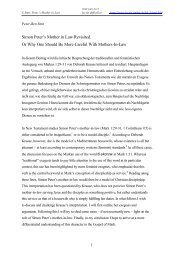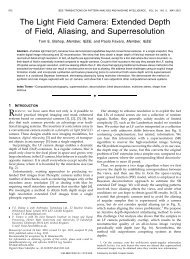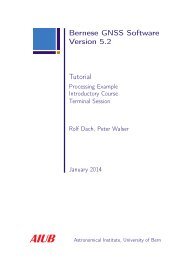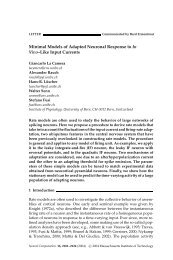Deploying Real-Life WSN Applications: Challenges ... - IAM - CDS
Deploying Real-Life WSN Applications: Challenges ... - IAM - CDS
Deploying Real-Life WSN Applications: Challenges ... - IAM - CDS
You also want an ePaper? Increase the reach of your titles
YUMPU automatically turns print PDFs into web optimized ePapers that Google loves.
International Journal of Distributed Sensor Networks 5<br />
The smaller the value of the state is, the better the link<br />
condition is. When the PDR value is high, we prefer a light<br />
antijamming strategy. Thus, we choose the smaller state.<br />
When the PDR is not that good, for the sake of effectiveness,<br />
we choose a worse case as the system state.<br />
4.2. Transition Probability. Since the state of nodes changes<br />
due to the varying jamming conditions, the transition<br />
probability of the states also describes the variation of<br />
jamming signals.<br />
The transition probability is acquired by analyzing<br />
historical data. The nodes record number ki<br />
δ of the node<br />
reaching the state i ∈ S and performing action δ. If the state<br />
changes to j at the current period, then the nodes add one<br />
to the variable ki δ → j that keeps the total number of the state<br />
transitions from i to j for action δ. When S(t − τ) = i and<br />
S(t) = j, then the transition probability can be calculated as<br />
P δ (S(t − τ), S(t)) =<br />
Pr(S(t − τ), S(t), δ)<br />
Pr(S(t − τ), δ)<br />
= kδ i → j/k i<br />
k δ i /k i<br />
= kδ i → j<br />
ki<br />
δ ,<br />
where k i is the total number of nodes that reach the state i.<br />
4.3. Cost of Antijamming Techniques. The cost function is<br />
about the energy consumption caused by the antijamming<br />
techniques.<br />
4.3.1. Adjusting Transmission Power. The cost of increasing<br />
transmission power is easy to compute. It is the raised power<br />
multiplied by the packet transmission time,<br />
n∑<br />
n∑ P tx L pkt<br />
C I = P tx t pkt = , (5)<br />
R<br />
i=1<br />
i=1 bits<br />
where C I is the cost of the increasing power action; the time<br />
of transmitting every packet is t pkt ; L pkt and R bits represent<br />
packet length and the bits transmission rate, respectively; n<br />
is the total number of packets within one period τ when the<br />
node is performing that technique.<br />
4.3.2. Error-Correcting Codes. The energy consumed by<br />
this technique is the power used for the encoding and<br />
decoding process and transmitting the redundant bits. For<br />
the error-correcting codes has to be undertaken by both<br />
of the communicating nodes, the notification process also<br />
consumes extra energy.<br />
As the notification process is all the same and will not<br />
change, therefore, the energy expended is a constant. With<br />
this information, we have the cost function of the errorcorrecting<br />
codes technique as<br />
n∑ ( ) Ptx L<br />
C EC<br />
EC =<br />
+ E noti . (6)<br />
R bits + E dec<br />
i=1<br />
L EC is the length of the encoded packets. Since there are more<br />
bits than the normal packets, L EC will be bigger than L pkt .<br />
(4)<br />
For this method, the nodes transmit the signals in a normal<br />
level of power. The first component of (6) is the energy<br />
for transmitting the packets. E dec is the energy spent for<br />
decoding the packets or correcting the errors of the received<br />
signal. In [18] the author gives a method to calculate the<br />
computing energy cost.<br />
E noti is the energy expended for the notification process.<br />
Because this process is invariable, it just equals the multiplication<br />
of the normal power level and the time spent for this<br />
process.<br />
Added up this tree part of the energy, we will get the total<br />
energy consumed by the error-correcting strategy.<br />
4.3.3. Channel Surfing. The nodes also transmit their signals<br />
in normal power in this technique. As the error-correcting<br />
code strategy, the nodes have to notify the neighbors<br />
that it will change to another channel, for the neighbors<br />
undertaking the same strategy to keep the connectivity of<br />
the network. Secondly, when the nodes take this strategy, the<br />
intermediate nodes also need to send some packets when it<br />
switches to each channel. The total cost could be<br />
m∑ P<br />
C tx L noti<br />
n∑ P tx L pkt<br />
CS = + + E noti . (7)<br />
R<br />
i=1 bits R<br />
i=1 bits<br />
E noti is just like the error-correcting codes, for the notification<br />
process is all the same. In this strategy, the node has<br />
to inform the neighbors when it goes to a new channel. The<br />
P tx L noti /R bits is the energy expended to send those packets. m<br />
means the total channel switches. The energy consumed by<br />
data packets is the second part in (7).<br />
4.4. Policy Determination. In the following, we use PDR to<br />
describe performance reward,<br />
and we define:<br />
R δ(t−τ) (Q(t − τ)) = PDR(t) − PDR(t − τ), (8)<br />
γ iδ = 1 − R δ(t) (S(t)), (9)<br />
λ iδ = γ iδ C δ , (10)<br />
where λ iδ is the cost of technique δ at state i.<br />
Because γ iδ is a coefficient of the cost, (9) makes the more<br />
effective technique that has higher reward and less energy<br />
cost. It results in a smaller γ iδ when the jamming is severe.<br />
Then, the cost λ iδ will become less than the techniques with<br />
less energy cost, for the value γ iδ of the lighter technique<br />
is probably greater than one. Therefore, the node is more<br />
likely to perform a more effective technique to guarantee a<br />
certain communication quality. On the other hand, when the<br />
jamming is not serious, a heavy technique does not gain so<br />
much reward that makes the cost less than the lighter ones. In<br />
such a case, the technique with less energy cost is preferred.<br />
Based on the previous definitions, we devise the policy<br />
improvement algorithm to solve the MDP problem. The<br />
details of this algorithm are explained as follows.

















